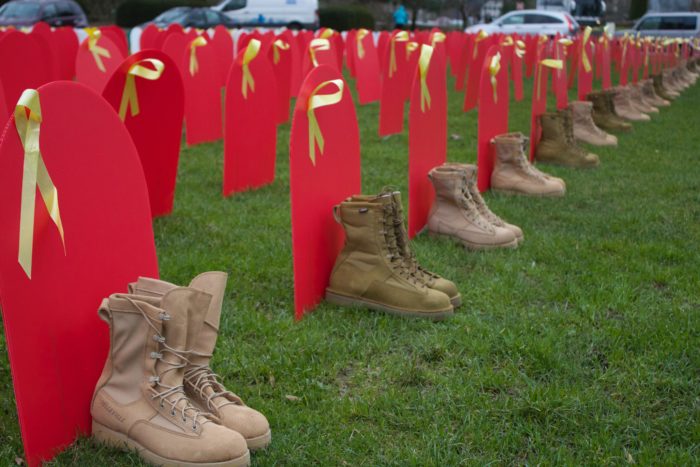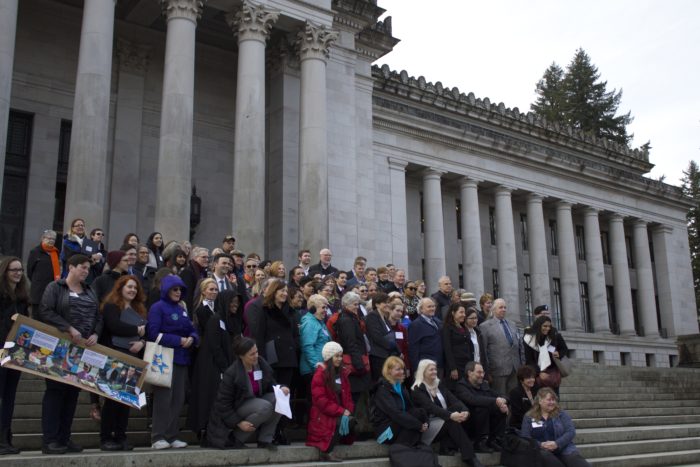
Why were there 1,129 fake tombstones on the lawn of the state capitol building in Olympia last month?
University of Washington-based organization Forefront: Innovations in Suicide Prevention created the “Suicide-Safer Homes Memorial” to represent the 1,129 people who died from suicide in 2015.
There were different colored tombstones to represent the different ways in which people took their lives. Red represented deaths from firearms, white represented suffocation, yellow represented poisoning, green represented jumping or cutting, and blue represented other means. In addition to the tombstones, there were 22 pairs of military boots and 225 yellow ribbons to represent veteran suicides.
The dramatic memorial was part of Forefront’s annual Education Day in Olympia, co-sponsored by the Washington Department of Veteran’s Affairs and the Crisis Clinic.
“What we are trying to do is raise awareness, because once we raise awareness we will get more constituents voices to legislatures, and more grassroots involvement, and that’s exactly what we need,” said Aimee Chou, media and communications specialist at Forefront.
Over 100 advocates and loss survivors came together for the event to promote three different suicide prevention bills before the State Legislature this year.

One of them, Bill 1379, would create a statewide, public web portal of free suicide prevention curriculum and form a grant program for suicide prevention funding in resource-challenged higher education institutions.
“We are trying to help the public understand the role they play in suicide prevention,” said Jennifer Stuber, faculty director for Forefront.
The second, Bill 1047, would expand secure medicine disposal options to reduce risks of old medicine being used for intentional overdoses. Right now it’s illegal for pharmacists to take back unused drugs, so they often remain in people’s houses long after they’re needed.
“There are so many things in your medicine cabinet that can be used to hurt yourself,” explained Ahmad Bennett, coordinator for the Center of Excellence for Veteran Students Success at Lake Washington.
Those two bills are moving rather slowly, but a third bill focused on firearms has more momentum. Over half of all suicides each year involve firearms.
The Safer Homes and Public Awareness Campaign Bill (1612) would provide funding to better train firearm dealers, pharmacists and other health care providers on suicide prevention.
“We are developing a training for gun dealers, because when someone buys a firearm, there are key questions the dealer can ask to see if someone is depressed or thinking of self harm,” Stuber said. “Gun dealers have the ability to not sell a firearm.”
Forefront and its allies face challenges in convincing people that suicide prevention education is necessary, advocating to legislators that a bill is the right answer to the problem, and informing people that suicide prevention works.
“There are people like my dad who think that if you’re depressed or sad, there is always that counselor or that one person who can help you out,” Chou said. “Unfortunately not everyone goes to church, and not everyone has insurance to see a counselor.”
Forefront wants to educate people on the fact that there is not one “specialized” person who can prevent suicide. Anyone can help.

“When I look at the markers (in the mock graveyard), I think of the lives, and I wonder is there hope? Can we see a light?,” said Jim Richards, a father who has helped his own daughter survive depression.
In addition to educating others on suicide prevention, Forefront also provides a community of support for loss survivors, attempt survivors, and those who or are feeling suicidal themselves or are concerned about someone else.
Part of the February education day also included a L.E.A.R.N. Suicide Awareness Training, aimed at informing people on the role they can play in preventing suicide and challenging the misconception that only counselors or therapists can help talk about suicide.
“Suicide is preventable, but it takes everyone. We need your help and your passion,” said John Wiesman, the secretary of Washington State Department of Health.
The L.E.A.R.N. training focused on five key components:
Look for warning signs
Emphasize and listen
Ask about suicide
Remove the danger
Next level of care
“Listening is the key to empathizing. There is never any harm in asking about suicide,” Bennett said. “If you’re on the fence about asking, ask.”
Last year, there were over 1.5 million phone calls to the the National Suicide Prevention Lifeline, and 41,000 Washington state residents who called.
“We are here to join with a unified voice, but I think that’s only half the battle. I think we need to approach suicide prevention with a unified ear. My mantra is it’s a scary thing to talk about the suicide, but the good news is we are talking about suicide,” said Michael Reading, director crisis services at the King County Crisis Clinic.
“We realized we were all in this together and there is hope,” Richards said, reflecting on the Education Day. “Maybe in the future we won’t all have to rely on luck to save those whom we care for.”
The National Suicide Prevention Lifeline is 1(800) 273-8255. More information on Forefront is available on their website.


Everyone’s? Does that include the leaders of our country? I venture to say there will be a surge in suicides over the next 3 years. Mark my words.